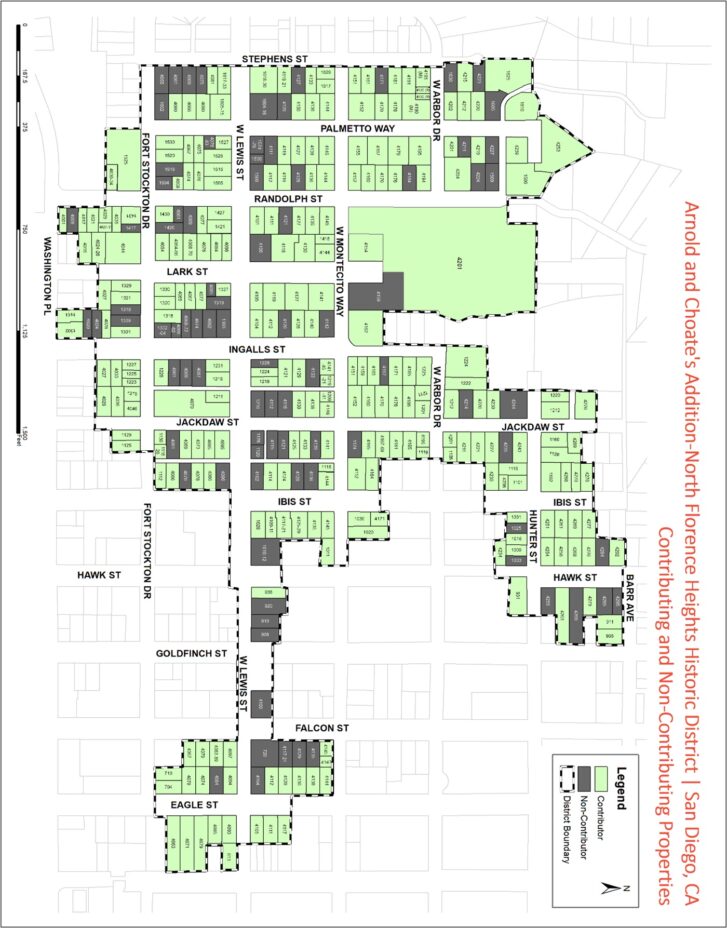Nomination for Arnold and Choate’s Addition/North Florence Heights Historic District to be heard by State Commission
By Mission Hills Heritage
Mission Hills Heritage has some exciting news to share about our nomination of the Arnold and Choate’s Addition/North Florence Heights Historic District (ACFH) for listing on the National Register of Historic Places. After two years of hard work and great expense researching and documenting this historic district and the more than 350 properties contained therein, our nomination has been accepted by the California State Office of Historic Preservation for consideration of this prestigious designation. The State Historical Resources Commission (SHRC) will consider this nomination at its May 3, 2024, meeting in Sacramento.
ACFH comprises approximately 69 acres in the Mission Hills neighborhood of San Diego. A map of the historic district accompanies this article.
The district’s boundaries generally correspond with the historical boundaries of two contiguous subdivisions: the 1872 Arnold and Choate’s Addition and the 1890 North Florence Heights. The original perimeter of the combined subdivisions has been modified to exclude some parcels that have experienced contemporary infill development and no longer relate to the district. The district also specifically excludes the Goldfinch/Washington Street commercial core area of Mission Hills and areas zoned for higher residential density.
The nomination report provides a full picture of the rich historical treasure that ACFH represents, and we encourage you to read it. The full report can be viewed at: www.missionhillsheritage.org/news/arnold-choates-north-florence-heights/.
ACFH is a splendidly intact representation of the early 20th century development associated with the expansion of the electric streetcar service in San Diego. Once the San Diego Electric Railway Company (SDERC) committed to bringing the streetcar line to Mission Hills – originally terminating at Lewis and Stephens Streets in front of the sales office of Kate Sessions’ plant nursery – development took off in ACFH in 1907. And this development exhibits features of an early streetcar suburb, including –
- Residential development on smaller, compact lots with modest houses that catered to middle-income households who aspired to move out from the city center, with some larger homes on the fringes;
- Relatively small-scale commercial properties integrated into the community (such as Mission Hills Nursery, Ibis Market, and the Rigdon mixed-use buildings on West Lewis Street); and
- Small-scale institutional properties woven into the community (for example, Francis Parker School, Mission Hills United Methodist Church, Mission Hills United Church of Christ).
And oh, the architecture! Per the nomination report, ACFH is “significant as a cohesive and intact concentration of early twentieth century residential architectural styles. Buildings within the district are designed in architectural styles that are compatible with one another and collectively express the visual vocabulary of San Diego’s early suburban neighborhoods.”
Under the influences of local master builders (such as Morris B. Irvin, Martin V. Melhorn, Nathan Rigdon, and more) and renowned architects (Louis J. Gill, Joel L. Brown, William H. Weaver, to name a very few), ACFH expresses an eclectic range of architectural styles – from early Vernacular Victorian-era residences through Craftsman and Period Revival styles on to Minimal Traditional styles in the later years.
While single family houses make up most of the residential units, 30 residential buildings in the historic district were originally built as multi-family residences (9% of the resources in the district).
So ACFH was and remains a charming district of single family and multi-family residences with supporting commercial and institutional buildings that, while adapting to changing times and mobility patterns, retains the architectural characteristics of its early twentieth century period of significance.
The public can register their support with letters sent to: State Historic Preservation Officer, Office of Historic Preservation, 1725 23rd Street, Suite 100, Sacramento, CA 95816-7100. In addition to the SHRC meeting to vote on the nomination on May 3, 2024, the San Diego Historical Resources Board (HRB) will weigh-in on the nomination at its April 25, 2024, meeting.
Unfortunately, not everyone values the architectural gems that line the streets of ACFH. Various interest groups have recently become more hostile to historic preservation in general and historic districts in particular. Individuals affiliated with building industry organizations have begun circulating misleading propaganda about the district with false and exaggerated claims, including that no development will be allowed within the district and that the standards for the National Register are more “lenient” than the local register. In reality, ADUs and Junior ADUs can still be built on properties within such a historic district, regardless of whether the properties are contributors or non-contributors. The nomination standards for the National Register are quite stringent, as evidenced by the 155-page nomination report for this district.
This district will help preserve the rich architectural history and sense of place that embodies the Mission Hills neighborhood and has drawn generations of residents to the area. We look forward to this newest addition to the historic districts in our community. You can support our important work by making a donation to Mission Hills Heritage on our website at: www.missionhillsheritage.org.

Category: Architecture, Government, Historical, Housing, Local News, Nonprofit







